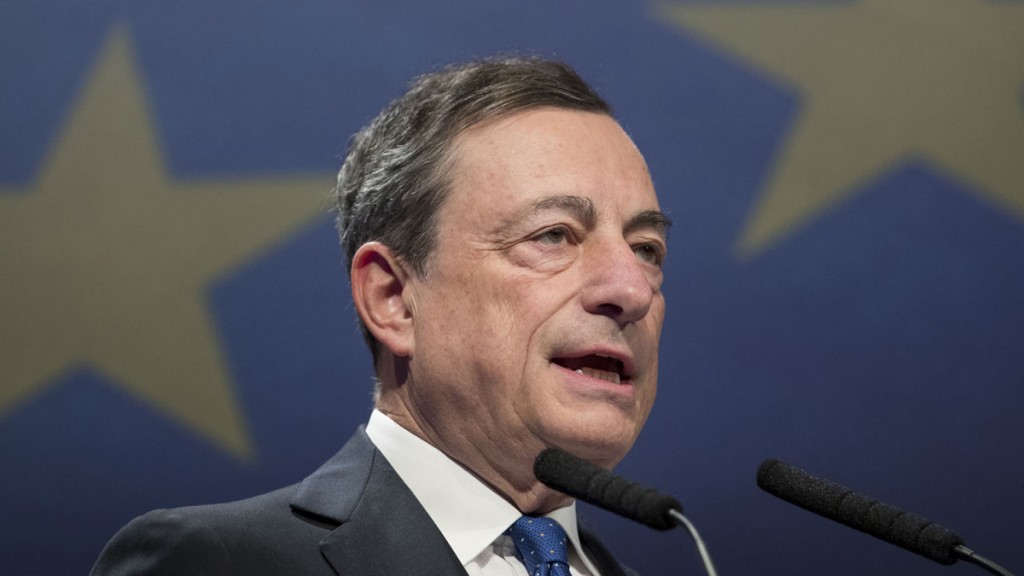
As per usual, it took markets a while to figure out what European Central Bank boss Mario Draghi had done yesterday.
At first the euro spiked higher when it turned out that he was planning to reduce the amount of monthly money printing.
Then it spiked lower as markets realised he was still going to be printing money for a lot longer than they’d expected.
And in the end, equity markets decided it was time to party on.
So what’s he up to?
The European Central Bank’s cunning new plan
Here’s what the European Central Bank (ECB) did yesterday. It had been printing €80bn a month. Now – or rather, from April 2017 – it’s going to print €60bn a month.
So that’s tapering, right? Nope. Not exactly. It’s actually “calibration”, says ECB boss Mario Draghi.
When the US Federal Reserve started to cut back on the amount of quantitative easing (QE) it was doing, it had a final date in mind. So it was a gradual wind down.
The ECB is different. Before yesterday’s meeting, the plan was to buy €80bn a month, but only until the end of March 2017.
Now, it’s reduced the monthly amount it’s buying, but it’s extended the amount of time over which it will buy. So it’s going to buy €60bn a month of bonds – but now the programme will run up to the end of December 2017, rather than a three-month extension, which is what the market expected.
So it might be doing the QE at a slower rate, but it’s also going to be doing a lot more of it over the longer run.
Draghi has also changed some of the limits on the ECB’s bond buying restrictions. He’ll now buy bonds with a yield of less than -0.4% if he reckons it’s necessary. He can also buy one-year bonds if he wants to (before now he couldn’t).
That makes it a little bit easier to steepen the yield curve. That’s jargon-y, but it’s important, because it makes it that bit easier for banks to turn a profit. Banks borrow money in the short term, to lend it at higher rates in the long term. So the bigger the gap between short-term interest rates and long-term interest rates (the steeper the “yield curve”), the better it is for bank profitability.
Overall, the market liked it. It got more money printing, but it didn’t get any signs of obvious panic, and the ECB still held the door open to extending the scheme further if necessary.
European stocks rose on the back of the idea that the ECB will be loitering around the bond market with intent for a long time to come.
The point is – the ECB is still willing to help, which the markets like. But it’s also willing to ease off on the QE pedal because it hopes that it won’t need to worry as much about deflation.
May 2017 will be a big turning point for Europe, one way or another
But as Draghi himself admitted, there’s only so much that the ECB can do.
As Stefan Isaacs of the M&G Bond Vigilantes blog notes: “we have reached a tipping point. For each additional measure of monetary stimulus there is an equal or greater cost to be borne elsewhere in the economy: banks, insurers and savers the obvious losers.”
So if Europe wants to fix its problems, then it’s going to boil down to the politics.
Either Europe knuckles down and reforms both national and EU-wide politics to allow countries to rub along without shattering the eurozone. Or one or more countries crack, and decide to up and quit.
And that’s what 2017 is going to be about in Europe.
There’s no question that electorates are in the mood for ditching the “old ways”. France is the ultimate microcosm of all this. Come May 2017, the two candidates left standing are likely to be Francois Fillon – a Frenchman who openly admits to admiring Margaret Thatcher (sacré bleu!) – and Marine le Pen, who openly admits to wanting to leave the euro.
So it’s no more of “le socialism” for France either way. You either get a centre-right reformer in charge who will attempt to restructure the French economy to make it more competitive. Or you get a hard-left nationalist (nationalists tend to believe in big government) who will take France out of the euro in order to have a free rein on spending.
Which will France opt for? One option could spark on of the biggest relief rallies on record as the eurozone wins another stay of execution (though given the French history of successful economic reform, it’s debatable how long that will last). The other could lead to the demise of the entire eurozone.
My gut feeling? Well, you can check that out in our 2017 forecasts issue, out today. If you’r enot already a subscriber, why not sign up now?